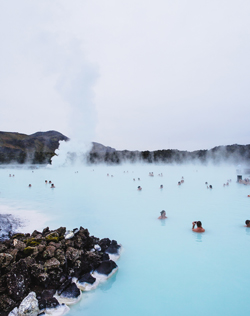Could a rise in local geothermal projects and the prospect of imported, volcanically sourced energy signal a greater role for geothermal in the UK’s energy future?
Whitchurch, A., Geothermal-powered nation.
Geoscientist 28 (9), 5, 2018
https://doi.org/10.1144/geosci2018-012; Download the pdf here
The sound of drilling pierces the air in the typically tranquil town of Penzance, Cornwall—earlier this year, work began on a geothermal well that will tap water naturally warmed underground to supply the town’s Jubilee swimming pool. Drilling a 1.4-km-deep well to heat part of a pool may seem indulgent, but the project raises the question of whether geothermal energy could realistically form a significant component of the UK’s low-carbon future.

Geothermal power is usually associated with volcanic regions, but active volcanism isn’t a pre-requisite. The temperature in Earth’s crust naturally increases by about 25-30°C per kilometre, so by drilling a few kilometres down into naturally permeable or artificially fractured rocks, and then pumping water to the surface, we can tap a persistent heat source with scarce carbon emissions.
Swathes of Southampton are heated by geothermal energy supplied by the Wessex Basin aquifer and work is underway to create a similar district heat network in Stoke-on-Trent. Plans have just been approved to develop a geothermal research observatory in Glasgow, with the aim of understanding the potential for water in flooded, abandoned mine shafts to heat the city. And on page 10 of this issue, Nadia Narayan and colleagues discuss the prospect of Carboniferous Limestone karst as a geothermal resource for the nation.
Such projects can only meet a portion of the UK’s energy needs because low geothermal gradients mean the wells can largely only be used for heat. To efficiently generate electricity requires high-enthalpy geothermal sources typically associated with active volcanism, which the UK does not have. But neighbouring Iceland does.
In 2009, the Icelandic Deep Drilling Project accidently struck a pocket of magma sitting just 2 km beneath Krafla Volcano. Steam streamed from the borehole. Rather than fill it, engineers cased the well and delivered the steam to the Krafla power plant, where it powered turbines and delivered an almost ten-fold increase in electricity compared to existing wells. Now, as part of the Krafla Magma Testbed project, volcanologists and geothermal engineers from around the globe are working with Iceland’s Geothermal Research Group to investigate the feasibility of magma-powered geothermal energy—energy that could potentially be exported to the UK (though Brexit has put paid to further discussion of a seafloor cable between Iceland and the UK).
Development of the UK’s geothermal resources has been slow, partly due to a cheap supply of fossil fuels from the North Sea. Given the growth of innovative local projects and emergence of several exciting research avenues, perhaps it’s time to consider geothermal energy as a notable part of the UK’s future energy mix.
AMY WHITCHURCH, EDITOR
[email protected]
Further reading:
https://www.kmt.is/
https://www.jubileepool.co.uk
https://nerc.ukri.org/press/releases/2018/31-glasgow/
https://www.bgs.ac.uk/research/energy/geothermal/heatEnergyGlasgow.html#minewaters
http://www.bgs.ac.uk/news/docs/2017/Krafla_Press_Release_2017.pdf
(Image credit: Jeff Sheldon)